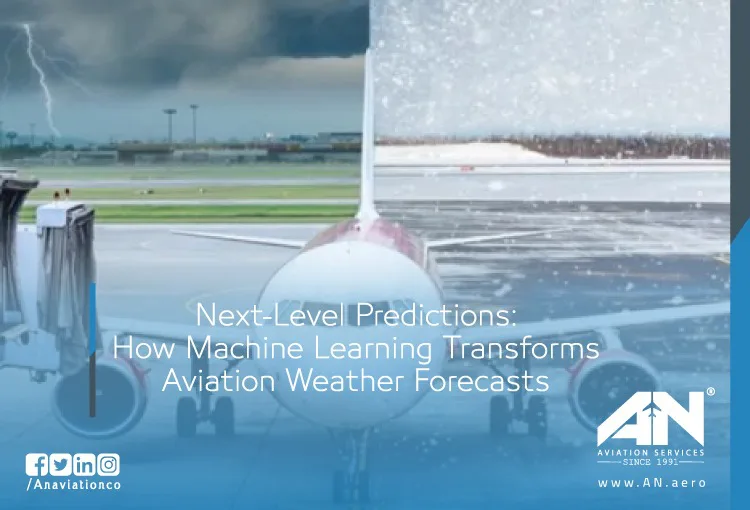
The aviation industry has long relied on accurate weather forecasting to ensure safe and efficient operations. From tracking surface temperatures to predicting wind speed, weather has a direct impact on flight safety, scheduling, and fuel efficiency. While traditional methods like Numerical Weather Prediction (NWP) models have served the industry well, a new wave of technology is revolutionizing how weather forecasts are made: machine learning.
Incorporating advanced technologies like neural networks and reanalysis data, machine learning offers unprecedented precision and adaptability, reshaping aviation weather forecasts. But what exactly does this transformation entail, and why does it matter for the future of air travel? Let’s explore.
How Machine Learning is Changing Weather Forecasting?
Weather forecasting traditionally relies on physics-based models, such as those developed by the European Centre for Medium-Range Weather Forecasts (ECMWF). These models use historical weather data and mathematical equations to simulate future conditions. While these systems, like numerical weather prediction (NWP), have proven effective, they also come with limitations, including high computational costs and slower processing times.
This is where machine learning steps in. By training models on vast amounts of historical and real-time weather observations, machine learning algorithms can identify patterns in weather data that traditional systems might miss. These patterns are then used to enhance weather prediction models, creating forecasts that are faster, more accurate, and better tailored to specific applications, such as aviation.
The Role of Neural Networks in Weather Prediction
At the heart of this transformation are neural networks, a type of machine learning model designed to mimic the way the human brain processes information. Neural networks excel at recognizing complex relationships within data, making them ideal for analyzing the intricacies of weather patterns.
For instance, neural networks can combine inputs such as surface temperatures, wind speed, and historical reanalysis data to generate accurate forecasts. These models can also adapt over time, learning from new data to improve their predictions—a capability that traditional physics-based systems cannot replicate as easily.
Aviation-Specific Applications of Machine Learning Forecasts
The integration of machine learning for weather forecasting is particularly valuable for the aviation industry, where small errors in forecasting can lead to significant challenges. Below are some key areas where machine learning is making a difference:
- Medium-Range Weather Forecasts (MRWF): Predicting conditions a few days in advance is crucial for flight planning. By leveraging machine learning, medium-range weather forecasts become more precise, helping airlines optimize routes and avoid weather-related delays.
- Wind Speed and Direction: For pilots and flight planners, understanding wind patterns is essential for determining fuel needs, adjusting flight paths, and maintaining safety. Machine learning models can analyze real-time wind speed data to make more accurate and localized predictions.
- Post-Processing and Short-Term Forecasting: While long-range predictions are valuable, short-term weather updates during flights are equally critical. Machine learning-powered post-processing systems can deliver real-time insights on turbulence, storms, and other immediate weather risks.
- Reducing Computational Costs: Traditional numerical weather prediction models require immense computational power, limiting their accessibility for smaller operators. Machine learning’s ability to process data efficiently reduces these costs, making advanced forecasts more widely available.
How Machine Learning Enhances Aviation Safety?
Weather conditions like storms, turbulence, and poor visibility are leading factors in aviation incidents. With machine learning’s ability to identify subtle patterns in weather data, pilots and air traffic controllers can receive more precise alerts about these hazards.
For example, prediction systems can provide detailed insights into controlled airspace conditions, giving pilots ample time to adjust flight paths. Moreover, machine learning can forecast the effects of extreme weather events on the ground, such as icy runways or high winds, helping airports better prepare for incoming flights.
Challenges of Machine Learning in Weather Forecasting
While the benefits of machine learning are clear, it’s not without its challenges. One significant hurdle is the quality of input data. Machine learning models are only as good as the data they’re trained on, which means inconsistencies or gaps in weather observations can affect accuracy.
Another challenge is the need for seamless integration with existing weather prediction systems. Many aviation stakeholders, including airlines and airports, rely on well-established tools, so adopting machine learning-based systems requires careful coordination.
The Future of Weather Forecasting in Aviation
As the aviation industry continues to evolve, the role of machine learning in weather forecasting will only grow. Initiatives like the European Centre for Medium-Range Weather Forecasts (ECMWF) are already exploring hybrid models that combine traditional physics-based systems with machine learning. These hybrid systems aim to deliver the best of both worlds—accurate forecasts at a fraction of the computational cost.
The adoption of machine learning also opens doors for customized weather solutions. Airlines could use specialized models tailored to their routes, while airports might leverage localized forecasts to manage operations more efficiently.
Ultimately, the goal is to create a future where accurate forecasts are not just a tool but a standard, ensuring the safety and efficiency of air travel in all conditions.
Conclusion: The New Era of Aviation Weather Forecasting
The integration of machine learning for weather forecasting marks a turning point for the aviation industry. By leveraging tools like neural networks and reanalysis data, this technology enhances the accuracy of forecasts, reduces operational costs, and improves safety.
While challenges remain, the potential of machine learning to revolutionize aviation weather forecasting is undeniable. As the technology matures, it promises to make air travel safer, more efficient, and better equipped to navigate the uncertainties of future weather patterns.

